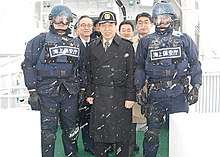Special Security Team
| Special Security Team | |
|---|---|
| Active |
(Kaikei-tai) 1985 - 1996 (SST) 1996 - Present |
| Country |
|
| Branch | Japan Coast Guard |
| Type | Police tactical unit |
| Role |
Counter-Terrorism Law Enforcement |
| Size | Classified |
| Part of | Directly under control of the Japan Coast Guard |
| Garrison/HQ | Osaka Special Security Station, Kobe, Japan |
| Nickname(s) | SST |
| Motto(s) | Semper Paratus (常に備えよ Tsune ni sonaeyo) |
| Engagements | Various anti-crime operations, Anti-North Korean spy ship skirmishes (1999-early 2002) |
| Commanders | |
| Current commander | Coast Guard Captain (Name Unknown) |
| Insignia | |
| Identification symbol | Small Japan flag on patch, Japan Coast Guard written in kanji and English on rear of tactical vest |
The Special Security Team (特殊警備隊 Tokushu-keibi-tai) is a counter terrorism tactical unit of the Japan Coast Guard, based at the Osaka Special Security Station (大阪特殊警備基地). The acronym of its Kanji name has already been used by other units[Note 1], the abbreviation "SST" is used for this team.[2][3][4]
Background
In 1985, the Maritime Safety Agency established the Maritime riot squad (関西空港海上警備隊 Kansai-kuko Kaijō-keibi-tai, Kaikei-tai)[5] to protect the maritime side of the Kansai International Airport cooperating with the land-side Riot Police Unit of the Osaka Prefectural Police. At the beginning of the establishment there were only 8 members, but as the airport construction started was strengthened to 24 operators.[6]
In 1990, due to the plutonium transport mission, the number of members was increased to 37 and the equipment was updated. A detachment corps for the escort mission was organized and called Onboard Security Team (警乗隊 Keijou-tai), but after the mission ended it joined again with Kaikei-tai. In 1996, it was renamed to its current unit name.[6]
Organization

Structure
Although detailed organization is not disclosed, it is said that under command of the team leader, seven sections consisting of eight operators are organized. Specialists such as EOD and EMT are assigned for each sections.[4]
SST is based at the Osaka Special Security Station (大阪特殊警備基地), adjacent to the Kansai International Airport, and able to be deployed nationwide by Saab 340B and Eurocopter EC225 Super Puma of the Japan Coast Guard.[4][3]
Recruitment and training
Members at the time of the establishment of Kaikei-tai were mainly scouted from Tokkei-tai.[Note 1][6] After establishing the structure as SST, it is recruiting personnel from the entire Japan Coast Guard.[7]
Because it was the first counter-terrorism unit for MSA, Kaikei-tai faced considerable difficulties. Combat techniques were acquired in the GSDF Ranger course at the Fuji school, but the maritime counter-terrorism operation was an unknown field thus the state of trial and error continued.[6] In 1991, Kaikei-tai received training from the United States Navy SEALs under the financial support of the SASAKAWA Foundation, techniques and tactics improved to world standards.[8]
Equipment
At the beginning, Kaikei-tai used 4-inch model of Smith & Wesson Model 19 revolvers as its main sidearms. In 1987, Howa Type 64 designated marksman rifles and Howa M1500 sniper rifles were added to its equipment.[6]
In 1988, Heckler & Koch MP5A5/SD6 submachine guns were adopted.[9] Pistols were updated to SIG Sauer P228 by 1992, and Howa Type 89 assault rifles were also introduced.[7] And it also has anti-materiel rifles manufactured by the McMillan Firearms.[10]
Operational history
In 1989, Kaikei-tai operatives were involved in storming a Panama-registered vessel after receiving requests via radio for assistance in the East China Sea near Okinawan waters after British officers were attacked by Filipino crewmembers during a riot. All of the arrested crew members were then taken into custody.[9]
In 1992, the Keijou-tai was deployed on board to guard ships carrying nuclear waste from France all the way to Japan, protecting them from any sort of staged attacks from any radical anti-nuclear activist groups.[7]
In 1999, patrol vessel Mizuho was dispatched to East Timor for non-combatant evacuation operation, and at this time, there is information that two sections of SST were on board to ensure the security of port facilities.[5][2]
The SST has participated in several Proliferation Security Initiative exercises recently in Australia.[11]
The SST was also responsible for apprehending Sea Shepherd protesters in 2008 after they were confronted by crewmembers of the Nisshin Maru.[12]
Notes
- 1 2 Special Riot Squads (特別警備隊 Tokubetsu-keibi-tai, "Tokkei-tai") are part-time deployable maritime law enforcement teams of each Regional Coast Guard Headquarters for riot control, port security or other maritime security operations.[1]
References
- ↑ Strike And Tactical Magazine 2017, pp. 74-75.
- 1 2 Kakitani & Kikuchi 2008, pp. 110-140.
- 1 2 Yoneda 2016.
- 1 2 3 Strike And Tactical Magazine 2017, pp. 65-73.
- 1 2 Komine & Sakamoto 2005, pp. 131-158.
- 1 2 3 4 5 Komine & Sakamoto 2005, pp. 45-74.
- 1 2 3 Komine & Sakamoto 2005, pp. 112-130.
- ↑ Komine & Sakamoto 2005, pp. 107-112.
- 1 2 Komine & Sakamoto 2005, pp. 75-106.
- ↑ Nakanomyo 2015.
- ↑ Iain Ballantyne (UK) and Yoshiharu Fukushima (Japan). "WEB SPECIAL - The Hunt for W.M.D." Warships Magazine. Retrieved 2010-05-27.
- ↑ "Unofficial SST Page" (in Japanese). Retrieved 2010-05-27.
Books
- Kakitani, Tetsuya; Kikuchi, Masayuki (2008). Japanese counter-terrorism units (in Japanese language). Sanshusha Co.,Ltd. ISBN 978-4384042252.
- Komine, Takao; Sakamoto, Shinichi (2005). SST - the Japan Coast Guard Special Forces (in Japanese language). Namiki-shobou. ISBN 978-4890631933.
- Strike And Tactical Magazine, ed. (2017). Special forces of Japan (in Japanese language). KAMADO. NCID BB01834038.
Articles
- Nakanomyo, Masami (October 2015). "History of shipboard guns on JCG's patrol vessels". Ships of the World (in Japanese language). Kaijin-sha (825): 168–173. NAID 40020597434.
- Yoneda, Kenji (July 2016). "JCG's special teams facing a new phase". Ships of the World (in Japanese language). Kaijin-sha (840): 152–157. NAID 40020863525.
See also
- Special Rescue Team
- Maritime Safety and Security Team - counterpart of the United States Coast Guard.
External links
- Unofficial SST information page (in Japanese)